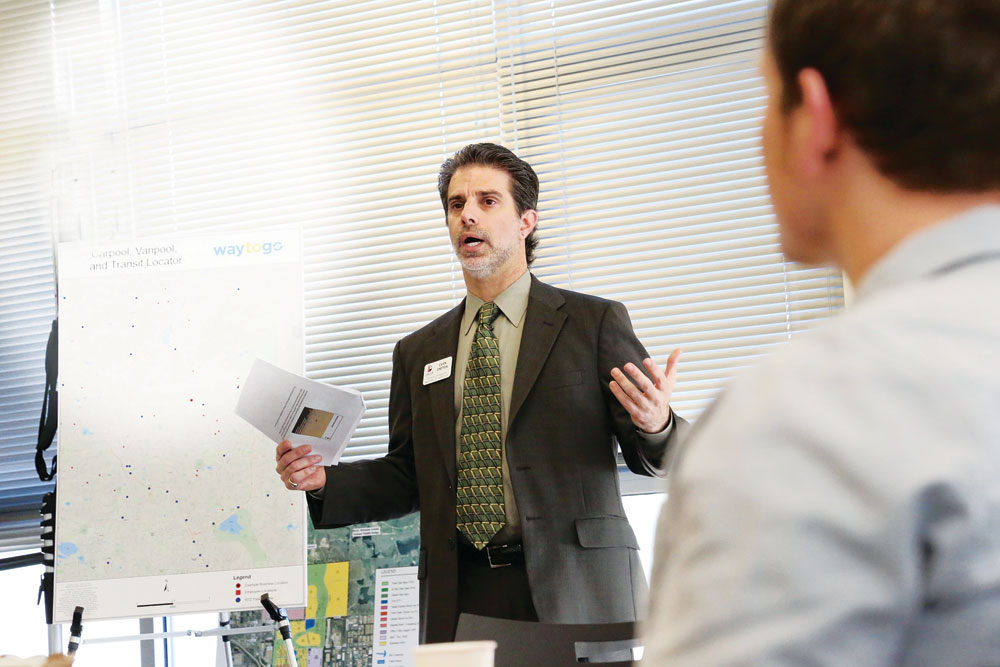
Evan Dreyer, Stapleton resident and senior advisor to the mayor, is pictured making a presentation about the aerotropolis concept at a meeting in Stapleton in February.
The vision of turning DIA into an “economic powerhouse” is close to being realized—but it rests on the outcome of a vote this fall by Denver and Adams County residents.
In January 2012, the Front Porch interviewed John Kasarda, known as the developer of the aerotropolis concept, who has said:
“The U.S. and Western Europe often view airports as nuisances and environmental threats rather than as critical infrastructure to compete and prosper. This has resulted in their maligning and neglecting airports while Asia and the Middle East invest heavily to leverage them. Such neglect comes at the long-term economic peril of the West.”
The recent agreement between Denver and Adams counties came after three years of discussions about an equitable distribution of the profits that could come from development at DIA. Evan Dreyer, deputy chief of staff for Mayor Hancock and one of the negotiators for Denver throughout the process, says right now the annual economic benefit of DIA to the entire region is $26.3 billion a year. “It’s the region’s number one economic driver—and that has been the subject of very detailed analysis how they arrived at that number.”
The original agreement under which Denver annexed 53 square miles of Adams County land to build DIA had specific clauses to protect Adams County’s economic interests. These clauses initially were the basis of disagreements between the parties. But both parties understood that benefitting from this vast economic potential hinged on a cooperative agreement—and that kept them talking, “week after week, month after month,” says Dreyer.
Under the new agreement, Denver will make a one-time payment of $10 million to Adams County and the two entities will have a 50-50 split of tax revenue from development of 1,500 acres in a pilot project (out of a total airport area of 34,000 acres). Dreyer says that agreement came early on in the talks. The primary reason it took three years was “so many different parties and so many different interests that needed to be heard, that needed to have their specific issues addressed.” Adams County Commissioner Erik Hansen concurs, and adds that many aspects of the discussion and agreement were very complex and had to be thoroughly researched and analyzed.
Denver’s $10 million payment will either come from the city’s general fund or from DIA. The total tax revenue to be generated from commercial use on the 1,500 acres is projected to be in the range of $150–270 million over 30 years, which will be split in half.
The FAA is making the determination whether the airport can be the source. If it comes from the general fund, city council will have to vote to approve it. If the pilot project is successful, it may be expanded, but no additional payments from Denver will be required.
The negotiations were between Denver and the Airport Coordinating Committee (ACC), which is composed of Adams County Commissioners and representatives from Aurora, Commerce City, Thornton, Brighton, and Federal Heights. Hansen, who chaired the negotiations for the ACC, explained that group has been in existence for 25 years, since the original airport agreement was signed. Their role has been, and will continue to be, to enforce the agreement with Denver about the airport.
A new entity at DIA called DEN Real Estate will guide the development of the 1,500 acres, which will not be contiguous; they will be wherever the airport decides are the best locations. The projected income of $95–185 million from land leases will go to DIA for infrastructure and development costs. Dreyer says, “One of the driving reasons for doing this deal is because airports all around the country are looking for ways to diversify their revenue portfolios in order to keep costs to airlines as low as possible. When you’re able to keep costs low, you are allowing airlines to maintain their existing flight routes, you are allowing airlines to look at expanding domestic routes, and, for us, perhaps most importantly, we are able to encourage airlines to look at new international flights, nonstop flights in particular, to and from DIA. That’s what a diverse revenue portfolio allows an airport like DIA to do.”
The new DIA agreement also calls for the creation of a second new entity composed of Denver and Adams County representatives with responsibility for joint regional marketing of this 1,500-acre pilot project. Their job will be to send new businesses to DEN Real Estate to develop projects at DIA.
What kinds of businesses might DIA attract? Dreyer says office users or additional light industrial users with supporting businesses such as retail, food and beverage, and other services to support employees and patrons. Panasonic Enterprise Solutions is already under contract to locate their operations base and assembly facility in the new transit-oriented development (TOD) along the East Rail at 61st and Peña Blvd. Dreyer says, “We estimate, at full buildout of those 1,500 acres, there would be an additional 12,300 direct jobs—and there’s the multiplier for indirect jobs.”
Hansen says 90 percent of the current Adams County voters were not active registered voters when the original airport vote was taken. “This is a different group of people than years ago. I really think that what people want is the communities of the Denver metro area to work together to try to accomplish something good. I think that’s how they’ll see this vote, and I’m optimistic that they’ll support it.”




0 Comments